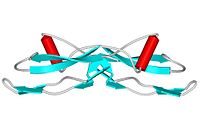
Photo from wikipedia
Glial cell-line derived neurotrophic factor (GDNF) is a promising therapeutic molecule to treat Parkinson’s disease. Despite an excellent profile in experimental settings, clinical trials testing GDNF have failed. One of… Click to show full abstract
Glial cell-line derived neurotrophic factor (GDNF) is a promising therapeutic molecule to treat Parkinson’s disease. Despite an excellent profile in experimental settings, clinical trials testing GDNF have failed. One of the theories to explain these negative outcomes is that the clinical trials were done in late-stage patients that have advanced nigrostriatal degeneration and may therefore not respond to a neurotrophic factor therapy. Based on this idea, we tested if the stage of nigrostriatal degeneration is important for GDNF-based therapies. Lentiviral vectors expressing regulated GDNF were delivered to the striatum of rats to allow GDNF expression to be turned on either while the nigrostriatal system was degenerating or after the nigrostriatal system had been fully lesioned by 6-OHDA. In the group of animals where GDNF expression was on during degeneration, neurons were rescued and there was a reversal of motor deficits. Turning GDNF expression on after the nigrostriatal system was lesioned did not rescue neurons or reverse motor deficits. In fact, these animals were indistinguishable from the control groups. Our results suggest that GDNF can reverse motor deficits and nigrostriatal pathology despite an ongoing nigrostriatal degeneration, if there is still a sufficient number of remaining neurons to respond to therapy.
Journal Title: Gene Therapy
Year Published: 2018
Link to full text (if available)
Share on Social Media: Sign Up to like & get
recommendations!